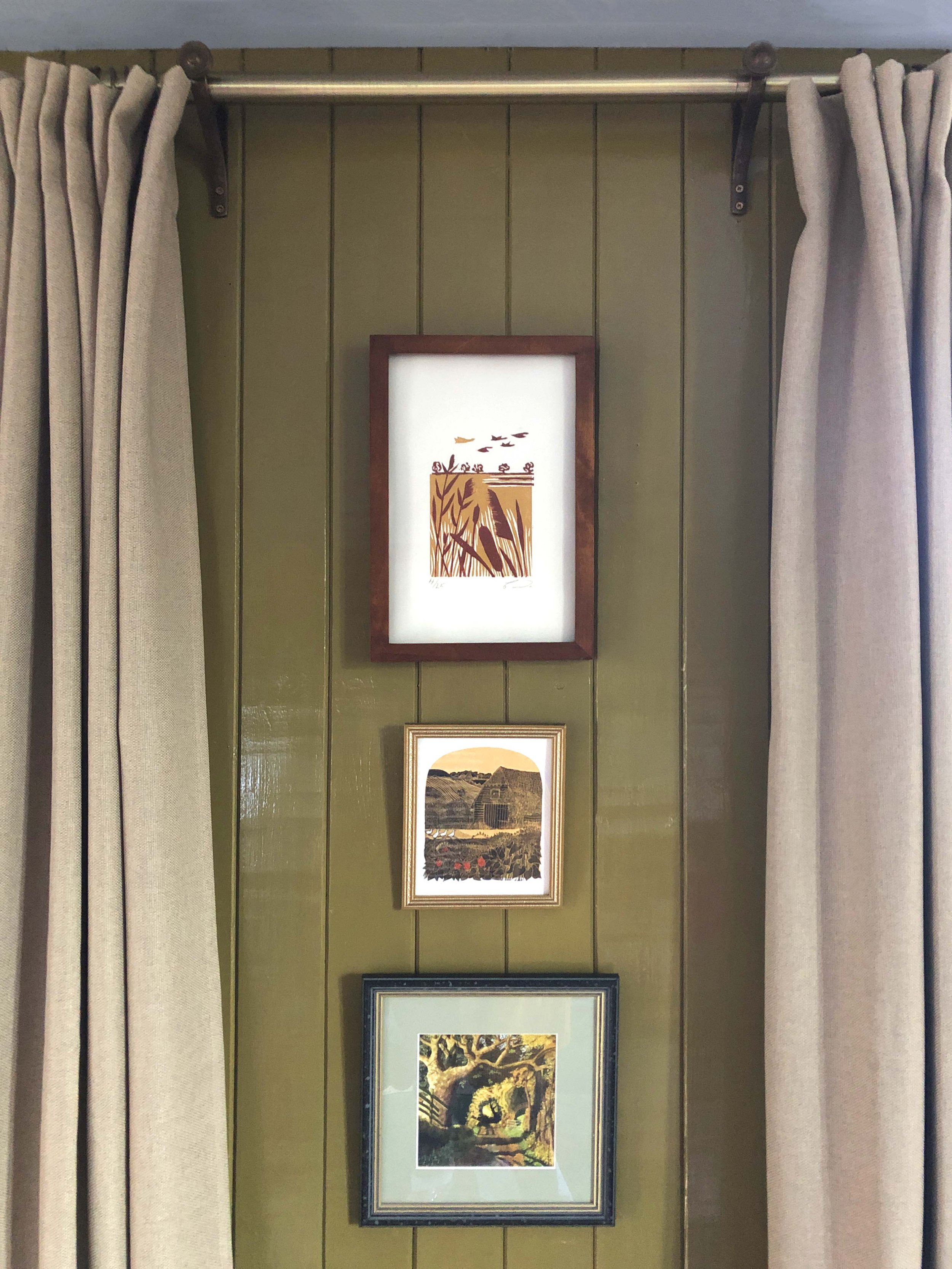Gloss paint is back!
Matt paint has been king for a long time now, whether on walls or cabinetry. It seems everyone has been in search of that illusive durable-but-velvety wall. Designer brands like Little Greene and Farrow & Ball sell chalky matt emulsion with about 2% sheen, but you have to go up to around 6% for a wipeable and scuff-proof finish. Eggshell paint gives you around 20-30% sheen and is popular for skirting, architrave and colourful painted kitchens.
So why am I talking about gloss, which is 80-90% shiny? It’s been creeping up the trend ladder for a few years, seen on this beautiful red door in Mathilda Goad’s ‘neo-country’ London home, and this fabulous citrine wardrobe in interior designer Lonika Chande’s Victorian terrace house. I saw both of these images and had a little lightbulb moment, and I’ve been lusting over glossy joinery ever since!
Where is gloss paint used?
I think this revival has come from the lacquer trend, but who has £3k to drop on a miniature lacquered bar cart from Nina Campbell? Paint is the next best thing. I’m seeing more gloss paint used in interiors, and no wonder as paint finishes are a fantastic way to add texture and depth to a scheme. By sticking to matt for so long, we’ve been depriving ourselves of this tool for creating variety and interest without adding too much clutter. Gloss finishes also bounce light around a room, which works particularly well for cosy evenings with lamp light as the nights draw in. Whilst I’m mainly sticking to woodwork for now, I’ve recently painted a ceiling in eggshell to bounce the light around in an otherwise matt room. Nicola Harding has gone the whole hog and lacquered the walls in this living room, which looks refreshing and sophisticated. A colourful gloss is also a fantastic way to make a regular radiator look like a designer one.
When to use gloss paint in your design
Let’s break down how to pull off a gloss paint without it looking dated. In years gone by, gloss has tended to be used in shades of white or cream (or white that’s yellowed with age!) on interior woodwork, with black used for exterior features. So if we want to avoid the Downing Street look it needs to be colour. Colours that work particularly well are punchy but a little dirty, such as Invisible Green by Edward Bulmer, Eating Room Red by Farrow & Ball and Blue Verditer by Little Greene.
Invisible Green - Edward Bulmer / Eating Room Red - Farrow & Ball / Blue Verditer - Little Greene
Here is one of my own colours, Wesley Olive, used for the previously-uninspiring panelling in the living room of my chapel home. When it was painted grey eggshell, it looked twee and created a cottage atmosphere that was at odds with the majesty of the chapel. The colour and gloss finish create a more fitting country-gentleman ambience, and I’m looking forward to adding to this with fitted bookshelves in future.
All the interior designers I admire have something in common: they know how to create tension in interiors. A slight juxtaposition – an unexpected colour or pattern, a modern piece in a traditional interior, that element of contrast – it what makes the difference between an average room and a great one. I’ve done that with colour in my shower room, and I used gloss paint to really make it pop. A completely contrasting colour would have looked fun and just as bold, but this clash of green against the stony colours creates that tension. Gloss paint is a great choice for bathroom woodwork as it helps to waterproof wooden surfaces and it’s very easy to clean.
How to paint with gloss
Paint technology is excellent these days, and water-based glosses go on just as well as oil-based paint (self-levelling so brush marks don’t show) so no need to compromise the environment in pursuit of a beautiful interior. My advice is to use a fine synthetic brush, or a short pile roller for larger areas. Preparation is key and you should follow the manufacturer’s advice to clean, sand and prime the surface you are painting. With gloss paint, bumps and imperfections will show up more. This doesn’t bother me as it suits the atmosphere of the old building I live in, but if you live in a more modern house it’s something to bear in mind. You may find you need more coats with a gloss paint, but it’s important to put it on in thin layers even if it’s patchy, otherwise you will get drips. Look over your surface for drips 5-10 minutes after applying your paint and smooth them out before they dry.
Why gloss paint won’t dry!
Out of all paint finishes, gloss takes the longest to set. Drying and curing are different, and paint that feels dry to the touch isn’t necessarily cured (cured means chemically set and stable). Whilst it is dry to the touch and recoatable in a matter of hours, gloss paint takes around 3 weeks to cure (dependent on brand). Before this you can mark it with fingerprints, and anything your put on the surface before it’s cured will leave a permanent mark. Even wiping with a cloth will affect the finish, so it’s important to stay away from it for 3 weeks! That doesn’t mean you can’t use the room, but don’t push furniture against newly painted skirting, avoid hoovering to the edges of the room, and leave shelves empty until the paint has cured. When using gloss in a bathroom or kitchen, make sure you don’t produce any steam whilst the paint is curing, otherwise it can leave the paint feeling sticky and like it has never dried out.
Which paint colour to choose
A little word on colour – colour charts and paint testers come in a matt finish, but colours look quite different in a gloss, usually a little darker and more saturated. Without the ability to get a true tester, you’re going to have to guess a little what colour to use to get the look you want. I actually think this is one of the wonderful things about interiors – just like when you commission an artist or buy a natural product – there’s always a bit of unknown about the final outcome! That’s what makes it a home unique, not a carbon copy of a showroom or photoshoot (read more about the personalised interior trend here).
So what do you think, could you ditch the eggshell for a colourful gloss?






